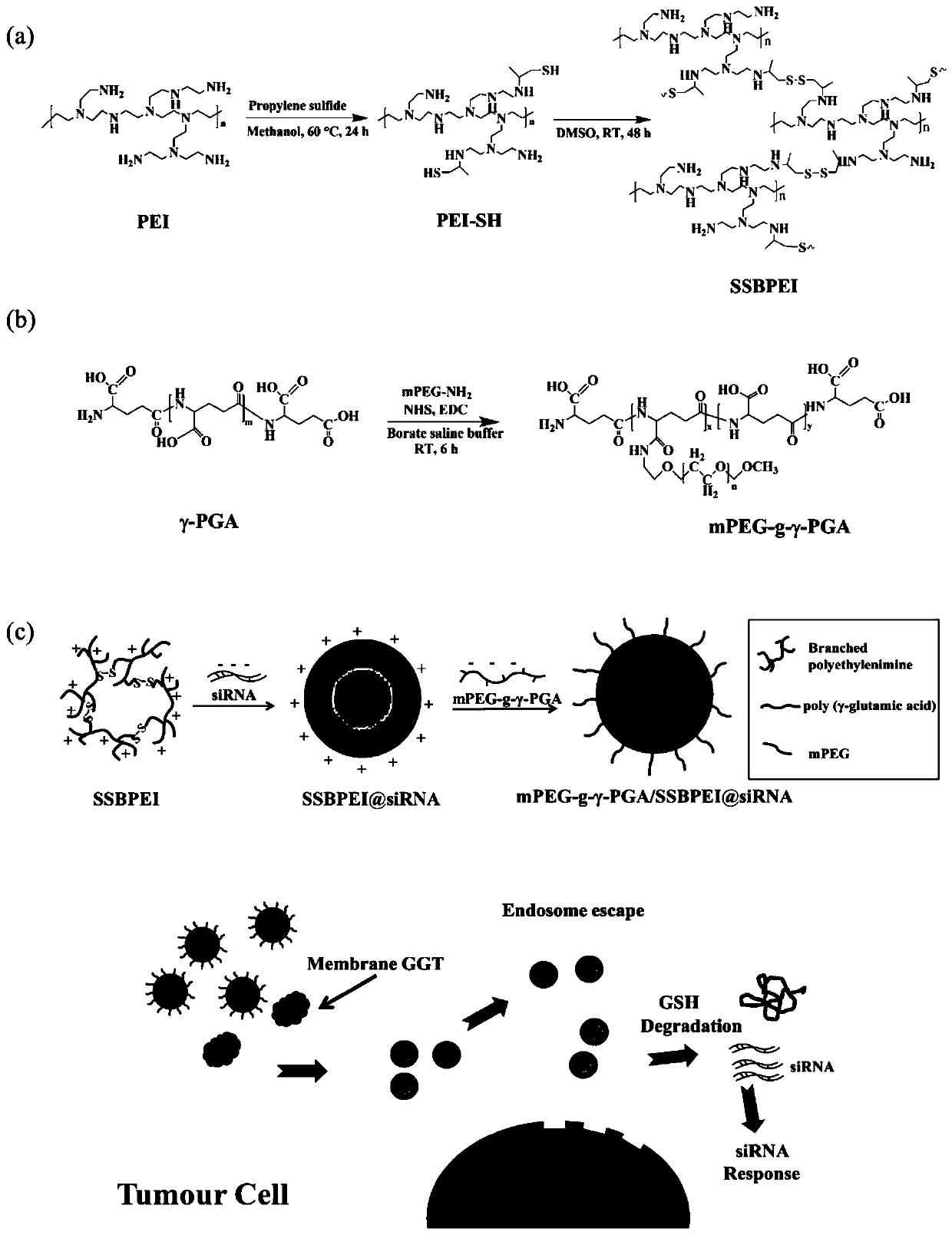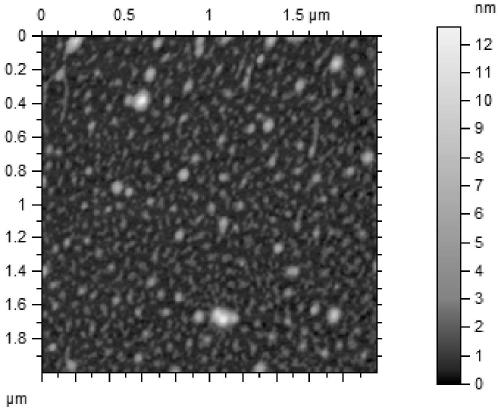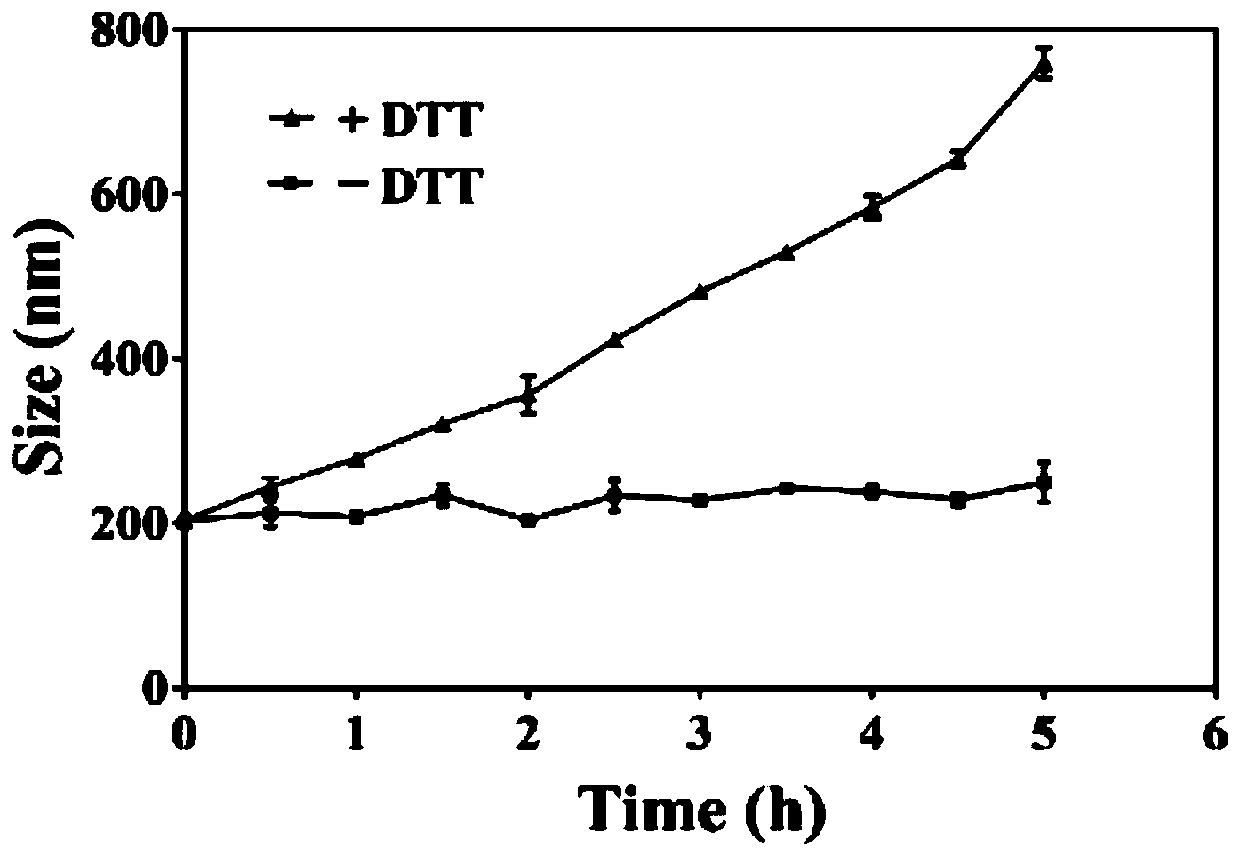Reductive polyglutamic acid/polyethyleneimine/siRNA composite nanoparticles as well as preparation and application thereof
A technology of polyethyleneimine and branched polyethyleneimine, which is applied in the application field of preparing tumor-targeted gene drugs, can solve the problems of high cytotoxicity and low gene transfection efficiency, and achieve the promotion of gene uptake and increase Active targeting, achieving the effect of passive tumor targeting delivery
- Summary
- Abstract
- Description
- Claims
- Application Information
AI Technical Summary
Problems solved by technology
Method used
Image
Examples
Embodiment 1
[0030] (1) Weigh 10 g of branched polyethyleneimine with a molecular weight of 1200, and dissolve it in 300 mL of deionized water to obtain a BPEI 1.2k aqueous solution. Adjust the pH value of the BPEI1.2k aqueous solution to neutral by adding 0.1mol / L hydrochloric acid solution dropwise, and freeze-dry for 3 days;
[0031] (2) Dissolve the solid obtained in step (1) with 300 mL of anhydrous methanol in a three-necked flask, blow nitrogen gas for 20 minutes to remove the air in the system, add 3.3 mL of propylene sulfide with a 1 mL syringe, and Stirring reaction under the protection of nitrogen for 18 hours;
[0032] (3) The product obtained in step (2) was dried under reduced pressure to remove the solvent, then dissolved in 200 mL of anhydrous methanol, precipitated twice through cold ether, and dried under reduced pressure to remove the solvent to obtain BPEI-SH;
[0033] (4) The obtained BPEI-SH was dissolved in 30 mL of dimethyl sulfoxide solution, and stirred and reacted...
Embodiment 2
[0041] (1) Sample configuration: Add 1 μL of different concentrations of BPEI25k, SSBPEI, and PBS solution (PH=7.4) of SSBPEI and mPEG-γ-PGA polymer to 3.6 μL of siRNA solution with a concentration of 20 μM. Incubate for 30 minutes to prepare BPEI25k@siRNA, SSBPEI@siRNA N / P ratios of 1:1, 5:1, 10:1, 20:1 nanoparticles, and the mass ratio of mPEG-γ-PGA to SSBPEI@siRNA 0.5:1, 1:1, 2:1 SSBPEI@siRNA / mPEG-γ-PGA respectively. Add 2 μL of 6×RNA sample buffer to each solution with a pipette gun, pipette evenly and set aside.
[0042] (2) Agarose gel configuration: Weigh 0.3g of agarose and place it in a conical flask, add 30mL of 1×Tris-acetate-EDTA buffer solution and shake well, cover with a small beaker, then put the conical flask into the microwave Heat until the agarose is completely dissolved. When the heated agarose is cooled to about 60°C at room temperature, add 3uL of ethidium bromide (EB), shake well, then transfer the solution to the gel plate with the comb inserted, sha...
Embodiment 3
[0053] (1) Cytotoxicity: Take the A549 cells to be treated out of the incubator and place them in an ultra-clean workbench, absorb the original culture medium with a pipette gun, add PBS solution to wash twice, and then add 400 μL of trypsin digestion solution to carry out For digestion, place the culture bottle in a 37°C incubator for digestion for about 3 minutes, and then use a microscope to observe the conditions of the cells in the culture bottle. When the cells become round and the intercellular space becomes larger, the trypsin digestion solution is removed, and a certain amount of medium containing 10% FBS is added to terminate the digestion. Gently blow with a pipette to make a single-cell suspension, count it with a hemocytometer, and dilute it to a concentration of 5×10 4 cells / mL single cell suspension. Take out the 96-well plate, add 100 μL of the above cell suspension to each well, place it in the operating table for 10 minutes, and then put it in a 37°C incubat...
PUM
 Login to View More
Login to View More Abstract
Description
Claims
Application Information
 Login to View More
Login to View More - R&D
- Intellectual Property
- Life Sciences
- Materials
- Tech Scout
- Unparalleled Data Quality
- Higher Quality Content
- 60% Fewer Hallucinations
Browse by: Latest US Patents, China's latest patents, Technical Efficacy Thesaurus, Application Domain, Technology Topic, Popular Technical Reports.
© 2025 PatSnap. All rights reserved.Legal|Privacy policy|Modern Slavery Act Transparency Statement|Sitemap|About US| Contact US: help@patsnap.com



